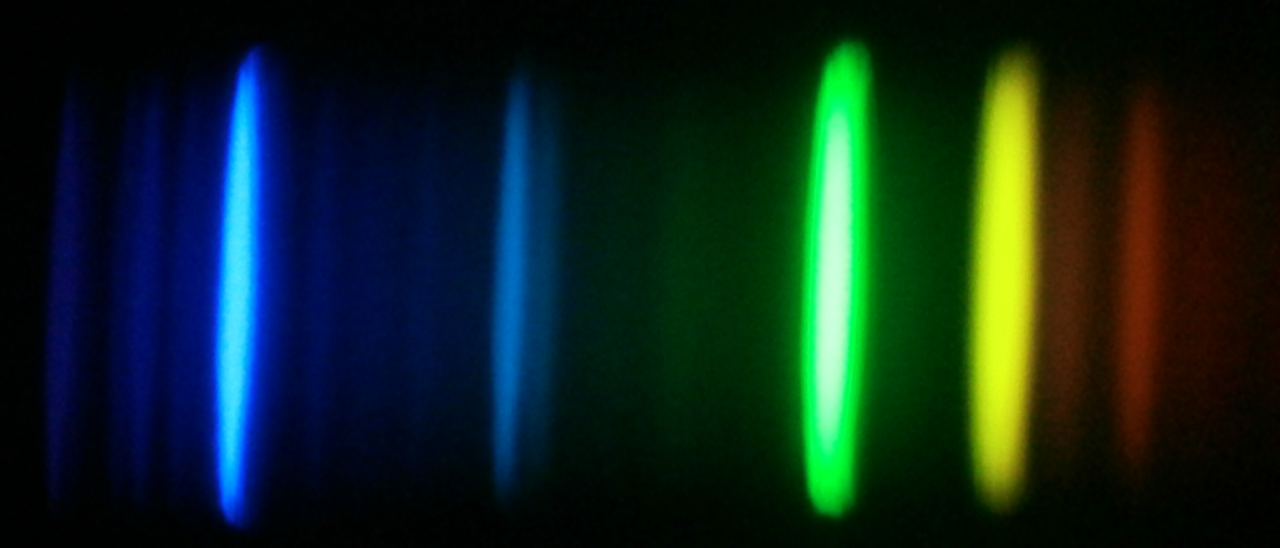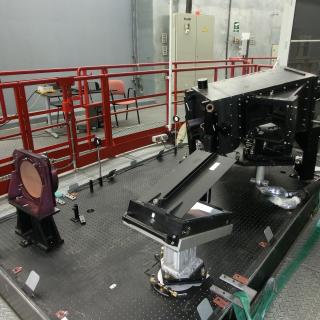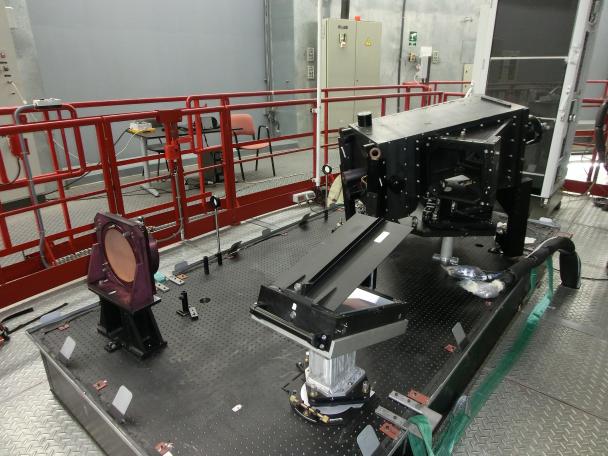Grants related:
General
Stellar spectroscopy allows us to determine the properties and chemical compositions of stars. From this information for stars of different ages in the Milky Way, it is possible to reconstruct the chemical evolution of the Galaxy, as well as the origin of the elements heavier than boron, created mainly in stellar interiors. It is also possible to study stellar formation, and the formation of the Galaxy, from the signature of the Galactic potential on the stellar orbits, and the distributions of mass, ages, and the abundance of heavy elements.
Obtaining high-resolution spectra, as necessary for studies of chemical compositions, requires advanced and efficient instrumentation. This is particularly true for research that calls for large stellar samples, which demands the observation of hundreds or thousands of sources simultaneously. Efficiency requires that the data processing and analysis are performed in an automated way.
The interpretation of spectra is based on physical models of the atmospheres of the stars, from where the light that we observe escapes the stars. The main ingredients for building such models are the fluid dynamics, and the properties of the atoms, ions, and molecules, especially regarding their interactions with the radiation coming from the stellar interior.
Once we have a plausible model, it is possible to compute in detail how the radiation propagates through the stellar atmosphere, and the emergent spectrum, which can then be iteratively compared with the observations to refine the model.
This project covers three different research fronts:
- Improving model atmospheres and simulations of stellar spectra.
- Developing tools for acquisition, reduction, and analysis of spectroscopic observations, in particular for the determination of chemical abundances in stars.
- Designing, preparing, and executing spectroscopic studies of stars aimed at understanding a) the most relevant aspects of the physics of stellar atmospheres, b) the formation and evolution of stars, c) the origin of the chemical elements, and d) the formation, structure, and evolution of the Milky Way galaxy.
Members
Results
- Complete the installation and commissioning of HORuS on GTC
- Discover two new stars with more than 100,000 times less iron than the Sun
- Complete the classification of all the APOGEE spectra with K-means
- Publish a complete collection of model stellar spectra for stars O to M
- Identify the signature of chemical diffusion in the atmospheres of the stars in the cluster M67
Scientific activity
Related publications
-
Sodium and Oxygen Abundances in the Open Cluster NGC 6791 from APOGEE H-band Spectroscopy
The open cluster NGC 6791 is among the oldest, most massive, and metal-rich open clusters in the Galaxy. High-resolution H-band spectra from the Apache Point Observatory Galactic Evolution Experiment (APOGEE) of 11 red giants in NGC 6791 are analyzed for their chemical abundances of iron, oxygen, and sodium. The abundances of these three elements
Cunha, K. et al.Advertised on:
12015 -
Low-resolution optical spectra of ultracool dwarfs with OSIRIS/GTC
We present the results of low-resolution optical spectroscopy with OSIRIS/GTC (Optical System for Imaging and Low Resolution Integrated Spectroscopy/Gran Telescopio Canarias) for a sample of ultracool dwarfs. For a subsample of seven objects, based on 2 Micron Sky Survey (2MASS) NIR photometric colours, a `photometric' spectral type is determined
Metodieva, Y. et al.Advertised on:
22015 -
The APOKASC Catalog: An Asteroseismic and Spectroscopic Joint Survey of Targets in the Kepler Fields
We present the first APOKASC catalog of spectroscopic and asteroseismic properties of 1916 red giants observed in the Kepler fields. The spectroscopic parameters provided from the Apache Point Observatory Galactic Evolution Experiment project are complemented with asteroseismic surface gravities, masses, radii, and mean densities determined by
Pinsonneault, M. H. et al.Advertised on:
122014 -
The Gaia-ESO Survey: the chemical structure of the Galactic discs from the first internal data release
Aims: Until recently, most high-resolution spectroscopic studies of the Galactic thin and thick discs were mostly confined to objects in the solar vicinity. Here we aim at enlarging the volume in which individual chemical abundances are used to characterise the thin and thick discs, using the first internal data release of the Gaia-ESO survey (GES
Mikolaitis, Š. et al.Advertised on:
122014 -
Disk Survival in the Extremely Massive Association Cygnus OB2
Star formation in massive clusters proceeds under the influence of the intense ionizing flux emitted by OB stars. Among the massive star forming regions in our Galaxy, Cygnus OB2 is the best available target to study these processes given its relative proximity and large content of OB and low-mass stars. We present our preliminary results on the
Guarcello, M. G. et al.Advertised on:
2014 -
Tracing Chemical Evolution over the Extent of the Milky Way's Disk with APOGEE Red Clump Stars
We employ the first two years of data from the near-infrared, high-resolution SDSS-III/APOGEE spectroscopic survey to investigate the distribution of metallicity and α-element abundances of stars over a large part of the Milky Way disk. Using a sample of ≈10, 000 kinematically unbiased red-clump stars with ~5% distance accuracy as tracers, the [α
Nidever, D. L. et al.Advertised on:
112014 -
The Gaia-ESO Survey: the most metal-poor stars in the Galactic bulge
We present the first results of the EMBLA survey (Extremely Metal-poor BuLge stars with AAOmega), aimed at finding metal-poor stars in the Milky Way bulge, where the oldest stars should now preferentially reside. EMBLA utilizes SkyMapper photometry to pre-select metal-poor candidates, which are subsequently confirmed using AAOmega spectroscopy. We
Asplund, M. et al.Advertised on:
122014 -
The Gaia-ESO Survey: The analysis of high-resolution UVES spectra of FGK-type stars
Context. The ongoing Gaia-ESO Public Spectroscopic Survey is using FLAMES at the VLT to obtain high-quality medium-resolution Giraffe spectra for about 105 stars and high-resolution UVES spectra for about 5000 stars. With UVES, the Survey has already observed 1447 FGK-type stars. Aims: These UVES spectra are analyzed in parallel by several state-of
Smiljanic, R. et al.Advertised on:
102014 -
Bayesian distances and extinctions for giants observed by Kepler and APOGEE
We present a first determination of distances and extinctions for individual stars in the first release of the APOKASC catalogue, built from the joint efforts of the Apache Point Observatory Galactic Evolution Experiment (APOGEE) and the Kepler Asteroseismic Science Consortium (KASC). Our method takes into account the spectroscopic constraints
Rodrigues, T. S. et al.Advertised on:
122014 -
Accretion and Outflow in the Proplyd-like Objects Near Cygnus OB2
Cygnus OB2 is the most massive association within 2 kpc from the Sun, hosting hundreds of massive stars, thousands of young low mass members, and some sights of active star formation in the surrounding cloud. Recently, 10 photoevaporating proplyd-like objects with tadpole-shaped morphology were discovered in the outskirts of the OB association
Guarcello, M. G. et al.Advertised on:
92014 -
A new gravitational wave verification source
We report the discovery of a detached 20-min orbital period binary white dwarf (WD). WD 0931+444 (SDSS J093506.93+441106.9) was previously classified as a WD + M dwarf system based on its optical spectrum. Our time-resolved optical spectroscopy observations obtained at the 8 m Gemini and 6.5 m MMT reveal peak-to-peak radial velocity variations of
Kilic, M. et al.Advertised on:
102014 -
Deep SDSS optical spectroscopy of distant halo stars. I. Atmospheric parameters and stellar metallicity distribution
Aims: We analyze a sample of tens of thousands of spectra of halo turnoff stars, obtained with the optical spectrographs of the Sloan Digital Sky Survey (SDSS), to characterize the stellar halo population "in situ" out to a distance of a few tens of kpc from the Sun. In this paper we describe the derivation of atmospheric parameters. We also derive
Allende Prieto, C. et al.Advertised on:
82014 -
The APOGEE Red-clump Catalog: Precise Distances, Velocities, and High-resolution Elemental Abundances over a Large Area of the Milky Way's Disk
The Sloan Digital Sky Survey III's Apache Point Observatory Galactic Evolution Experiment (APOGEE) is a high-resolution near-infrared spectroscopic survey covering all of the major components of the Galaxy, including the dust-obscured regions of the inner Milky Way disk and bulge. Here we present a sample of 10,341 likely red-clump stars (RC) from
Bovy, J. et al.Advertised on:
82014 -
Ultra-short Period Binaries from the Catalina Surveys
We investigate the properties of 367 ultra-short period binary candidates selected from 31,000 sources recently identified from Catalina Surveys data. Based on light curve morphology, along with WISE, Sloan Digital Sky Survey, and GALEX multi-color photometry, we identify two distinct groups of binaries with periods below the 0.22 day contact
Drake, A. J. et al.Advertised on:
82014 -
The Vertical Metallicity Gradient of the Milky Way Disk: Transitions in [α/Fe] Populations
Using G dwarfs from the Sloan Extension for Galactic Understanding and Exploration (SEGUE) survey, we have determined the vertical metallicity gradient in the Milky Way's disk and examined how this gradient varies for different [α/Fe] subsamples. Our sample contains over 40,000 stars with low-resolution spectroscopy over 144 lines of sight. It also
Schlesinger, K. J. et al.Advertised on:
82014 -
IPHAS and the symbiotic stars. III. New discoveries and their IR spectral energy distributions
Context. The IPHAS Hα survey provides a rich database to search for emission-line sources in the northern Galactic plane. Aims: We are systematically searching for symbiotic stars in the Milky Way using IPHAS. Our final goal, a complete census of this class of objects in the Galaxy, is a fundamental figure for discussing their overall properties
Rodríguez-Flores, E. R. et al.Advertised on:
72014 -
The Gaia-ESO Survey: the Galactic thick to thin disc transition
Aims: The nature of the thick disc and its relation to the thin disc is presently an important subject of debate. In fact, the structural and chemo-dynamical transition between disc populations can be used as a test of the proposed models of Galactic disc formation and evolution. Methods: We used the atmospheric parameters, [α/Fe] abundances, and
Recio-Blanco, A. et al.Advertised on:
72014 -
The Catalina Surveys Periodic Variable Star Catalog
We present ~47,000 periodic variables found during the analysis of 5.4 million variable star candidates within a 20,000 deg2 region covered by the Catalina Surveys Data Release-1 (CSDR1). Combining these variables with type ab RR Lyrae from our previous work, we produce an online catalog containing periods, amplitudes, and classifications for ~61
Drake, A. J. et al.Advertised on:
72014 -
Extinction Maps toward the Milky Way Bulge: Two-dimensional and Three-dimensional Tests with APOGEE
Galactic interstellar extinction maps are powerful and necessary tools for Milky Way structure and stellar population analyses, particularly toward the heavily reddened bulge and in the midplane. However, due to the difficulty of obtaining reliable extinction measures and distances for a large number of stars that are independent of these maps
Schultheis, M. et al.Advertised on:
72014 -
The planetary nebula IPHASXJ211420.0+434136 (Ou5): insights into common-envelope dynamical and chemical evolution
While analysing the images of the IPHAS (INT/WFC Photometric Hα Survey of the northern Galactic plane) survey, we noticed that the central star of the candidate planetary nebula IPHASXJ211420.0+434136 (also named Ou5) was clearly variable. This is generally considered as an indication of binarity. To confirm it, we performed a photometric
Corradi, R. L. M. et al.Advertised on:
72014
Related talks
No related talks were found.Related conferences
No related conferences were found.News

The IAC is an internationalized Spanish research centre aiming to achieve major advances in the understanding of the laws that govern the origin and evolution of the various forms of matter/energy in the Universe. Outstanding results are expected in key areas of research such as Solar physics, Sun-Earth connections, Exoplanetary systems, Solar







